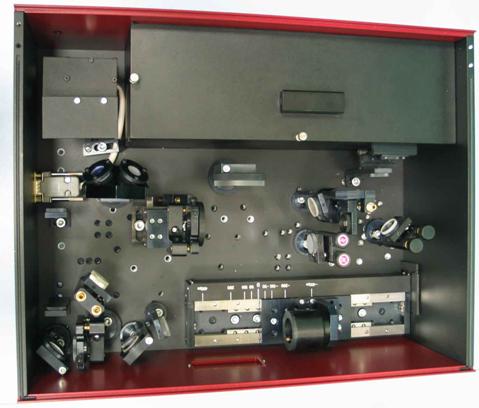
Del Mar Photonics - Rincon cross correlator brochure - Manual (sample)
Rincon Third Order Cross-Correlator (TOCC)
How good is the output from your femtosecond laser? The new third-order
cross-correlator Rincon was specifically developed for measuring a wide array
of output parameters from ultrafast laser systems including:
contrast ratio of
laser pulses, determining pulse pedestal, pre- and post-pulses, and amplified
spontaneous emission in femtosecond systems. It also provides information about
the third-order cross-correlation function of pulse intensity on a femtosecond
scale and can be used for alignment of high power femtosecond lasers. A portion
of the input pulse is converted to the second harmonic (SH) with a nonlinear
crystal. A dichroic mirror reflects the SH and transmits the fundamental thus
splitting the beam into the two arms of the crosscorrelator. The fundamental
beam arm includes a retro reflector and delay-line. After passing through the
delay-line the fundamental is recombined with the SH and focused into a DKDP or
BBO crystal (depending on the input pulse wavelength). Mixing the fundamental
and SH pulses in the nonlinear crystal produces non-collinear third harmonic
generation (TH). By filtering out the fundamental and SH frequencies, the TH can
be isolated.
Measuring the TH signal as a function of the optical delay between the
fundamental and SH pulses gives the third order cross correlation function. The
third order cross-correlator is ideal for looking at the full range of output
from amplified femtosecond laser systems. High temporal resolution over a long
(close to 1 ns) window shows pulse features that are usually missed, giving the
user a detailed and complete picture of the quality and stability of the output
pulse parameters of their femtosecond laser system.
Rincon cross-correlator includes opto-mechanical assembly and electronics
connected with USB interface for a PC. The system is easy to operate and
includes a full set of user friendly software tools for data collection and
analysis.
Each Rincon is optimized for customer laser system and required range of
measurements.
The complete setup geometry, dimensions of non-linear crystals and some essential optics
are all function of laser parameters and user-chosen tradeoffs between
sensitivity, time resolution, time window, overall size etc.
We need the following information to set the tradeoffs and get all critical
data necessary for the design which is optimized for your system:
1. What is wavelength of you laser system?
2. What is the repetition rate?
3. What is the normal pulse energy and beam diameter?
4. Is the laser pulse chirped?
5. What is the spectral bandwidth?
6. What is the pulsewidth?
7a. What is the expected (or estimated) contrast ratio as a function of delay from peak
7b. What is the minimum necessary contrast ratio as a function of delay from peak
8. What is beam quality (i.e. beam divergence relative to diffraction-limited one)

Below are few examples of Rincon cross-correlator specifications optimized for different customer requirements.
Rincon third order cross-correlator for 800 nm laser
(shipped to University Nebraska-Lincoln)
Wavelength, nm: 800
Dynamic range: 10^8
Temporal range, ps: 950
Input radiation energy (pulse 40-50 fs), μJ: 6-30
Pulse duration, fs: >20
Repetition rate, kHz: <3
Input polarization, linear: horizontal
Resolution: 100 fs
Dimensions, mm Optical unit
470 x 320 x 155 mm
Control unit
280 x 195 x 70 mm
Rincon third order scanning cross-correlator for 1054 nm
laser (Model 1633)
Wavelength, nm: 1054
Dynamic range: 1010
Temporal range, ps: 950
Input radiation energy (pulse 40-50 fs), μJ: 6-30
Pulse duration, fs: >20
Repetition rate, kHz: <3
Input polarization, linear: horizontal
Resolution: 100 fs
Power supply: 100-240 V, 50/60 Hz ± 10%
Dimensions, mm:
Optical unit - 470 x 320 x 155
Control unit - 280 x 195 x 70
To request a quote for Rincon cross-correlator please e-mail sales@dmphotonics.com with detailed answers to the questions above.